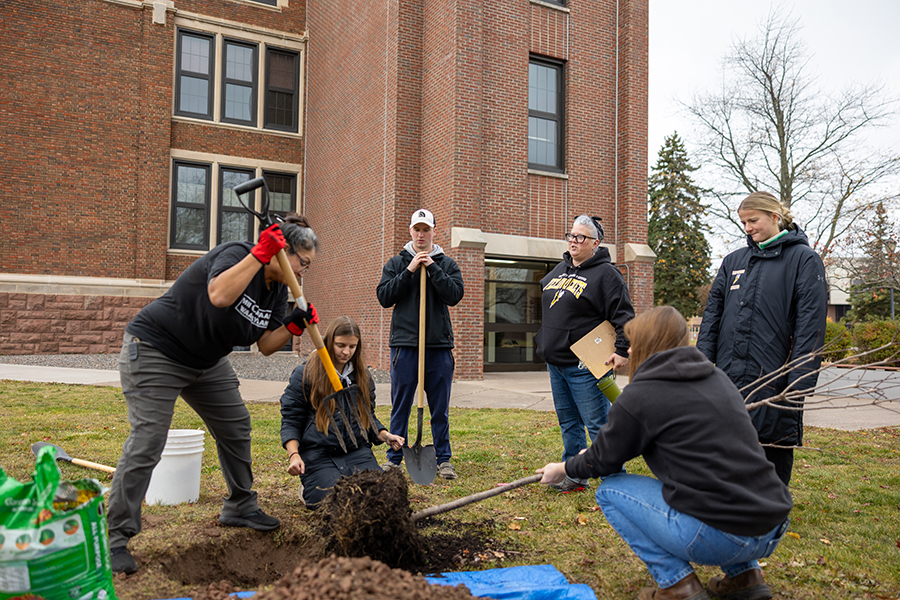TYPE
TOPIC
The University of Wisconsin-Superior prides itself by offering students real-world experiences that extend beyond the classroom.
Recently, 22 juniors and seniors enrolled in BIOL 415 – Ecology and Management of Forest Ecosystems took their indoor learning outdoors by planting trees across the UW-Superior campus. This hands-on activity was much more than an opportunity for fresh air – it represented the culmination of weeks of environmental research.
A Hands-On Lesson in Ecology
The BIOL 415 course at UW-Superior differs from other lab-based courses as it was designed to be a curricular undergraduate research experience (CURE). Purposefully designed to use the inquiry-based learning approach, the course provides the entire class with an opportunity to engage in scientific investigation and discovery with an unknown outcome.
“This is a great learning experience for students that they can use throughout the rest of their lives,” said Holly Johnson, environmental health & safety specialist III at UW-Superior. “They’re learning about different tree species, the environments where each grows best, tree placement and how to plant a tree properly.”
From Idea to Action
The project grew out of months of discussion among UW-Superior staff about adding more greenery to campus. A former professor initially volunteered the upcoming forestry class to help with the project but left the university before it could be completed. The responsibility then shifted to Michelle Frack, visiting lecturer in the Department of Natural Sciences, who took the lead in bringing the plan to life.
“I replaced a wonderful faculty member, Dr. Mark Grover,” said Frack. “He designed this forestry course before he left, and he had been in communication about incorporating tree planting into the curriculum. It’s exciting to see that vision realized.”
Turning Research into Practice
For Frack, the project offered her biology and environmental science students a deeper, more authentic research experience.
“There are plenty of higher-level science courses where students follow step-by-step lab instructions to get predictable results – and those certainly have value,” Frack said. “But this project is different. It gives students a chance to conduct real research, embedded within the curriculum, where they can ask bigger ecological questions.”
Before planting, students researched a range of topics – from ecological conditions on campus to the compatibility of native and non-native species, how different trees would coexist and even aesthetic considerations.
Expert Guidance and Local Partnerships
To ensure success, the class sought guidance from local forestry experts at Douglas County Forestry, the Cloquet Forestry Center, and the Lake Superior National Estuarine Research Reserve. These partnerships helped determine which species would thrive in northwestern Wisconsin’s unique climate and soil conditions.
“You have to think of an entire ecosystem when making decisions like this,” said Frack. “You can’t focus on just one plant or one space or one animal – you have to think about the whole system and what your goals are.”
Planting for the Future
The class planted 10 trees this year, with plans for future forestry classes to continue the project annually. Species planted include hackberry, American elm, eastern white pine, American basswood, white paper birch, Japanese tree lilac, mystic ruby buckeye, serviceberry, chokecherry and American plum. The trees were purchased from Gordy’s Farm Market, A+ Garden Center and Prairie Restorations, with funding provided by the UW-Superior Alumni & Friends Foundation.
“The Natural Sciences Department and Dean of Academic Affairs, Nick Danz, have been incredibly supportive,” said Frack. “When Holly first asked if I’d be interested in continuing the project, we didn’t know where the funding would come from or even which trees we’d plant – but Holly had the vision, and with her and Dean Danz’s support, we made it happen.”
Lasting Roots
For the students, the newly planted trees will serve as a lasting symbol of their work and dedication to the campus environment.
“As an alumna myself, I can see how a student would take pride in coming back to campus years later and saying, ‘I planted that tree!’” said Johnson. “It’s a meaningful experience that connects learning, community and stewardship – and one they’ll carry with them throughout their lives.”
That sentiment is especially true for BIOL 415 course member Abby Randall, an environmental science major and member of the Yellowjacket women’s soccer team from North Branch, Minnesota.
“I think it feels really special to be a part of a project that I know is going to positively impact students and the environment on our campus for years to come,” said Randall. “I’m excited to come back and visit after I have graduated and see how much the trees have grown.”
